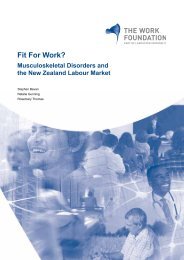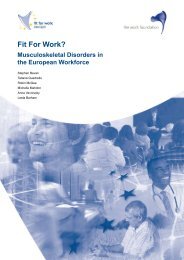FfW Bulgarian report (English language) - Fit for Work Europe
FfW Bulgarian report (English language) - Fit for Work Europe
FfW Bulgarian report (English language) - Fit for Work Europe
You also want an ePaper? Increase the reach of your titles
YUMPU automatically turns print PDFs into web optimized ePapers that Google loves.
2.4<br />
A note<br />
on definition<br />
Introduction<br />
Back pain and the majority of WRULDs are categorised as non-specific and episodic conditions<br />
which may frequently be caused by, or be made worse by, work. They manifest themselves in<br />
disparate ways and may cause periods of intense discom<strong>for</strong>t and incapacity which may affect<br />
the ability of the individual worker to carry out their work. They may also abate <strong>for</strong> long periods.<br />
Many people with these conditions, such as back pain, never seek treatment and most recover<br />
on their own but the conditions can cause significant absence from work or lost productivity.<br />
Back pain and WRULDs are often included in the occupational health and safety guidelines and<br />
literature. Occupational health practitioners typically deal with these conditions.<br />
On the other hand, RA and SpA are specific and progressive rheumatic diseases which are<br />
not caused by work, but may be made worse by work and are often handled by general<br />
practitioners and specialists, not within the occupational health arena. They are clinically<br />
diagnosed conditions that progress in a broadly predictable way, if untreated. They can have a<br />
significant impact on functional capacity at work and, in the long-term, participation in the labour<br />
market. Most people with these conditions require clinical interventions over a prolonged period<br />
of time and the management of these conditions <strong>for</strong> those of working age should involve the<br />
frequent and active participation of clinicians, employers and occupational health professionals.<br />
Together, these MSDs illustrate the effects of conditions from which a third of <strong>Bulgarian</strong> workers<br />
may <strong>report</strong> at any one time. Improving our understanding of the effects of these conditions, how<br />
staying in work can be beneficial, and what might be done to alleviate their impact, can yield<br />
significant social and economic benefits.<br />
In the absence of a consensus on a clinical definition of many MSDs, navigating the literature on<br />
their prevalence, incidence, diagnoses, epidemiology, treatment and cost to <strong>Bulgarian</strong> society<br />
is a difficult task. The lack of standardisation and validation of the terminology and classification<br />
of MSDs is one of the reasons <strong>for</strong> the contradictory findings in the literature regarding the<br />
diagnosis, epidemiology, treatment and rehabilitation of these conditions (WHO, 2003). Some<br />
clinicians differentiate between ‘musculoskeletal conditions’ and ‘musculoskeletal disorders’.<br />
The <strong>for</strong>mer refers to all clinical conditions affecting the musculoskeletal system and the latter, to<br />
borrow a definition from the ETUI (2007), meaning ‘any affliction of the musculoskeletal system<br />
that appears at work and causes discom<strong>for</strong>t, difficulty or pain when per<strong>for</strong>ming work’.<br />
Until 2007 Bulgaria did not have an official definition of work-related musculoskeletal disorders<br />
(Gladicheva and Chengelova, 2007). The most commonly used definition was defined by an<br />
expert group at the University Clinic of Occupational Diseases:<br />
<strong>Fit</strong> For <strong>Work</strong>? 15







